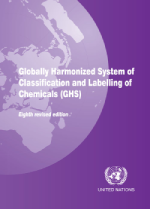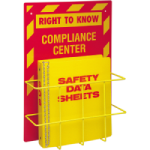Hazard Communication Standard

The Hazard Communication (Hazcom) Standard is an essential regulation required by the Occupational Safety and Health Administration (OSHA) that must be met by every printing operation, large or small. The regulation requires every printing operation using chemicals to train their employees in understanding the hazards associated with chemicals and several other hazards, such as combustible dust, and how to protect themselves from the hazards.
These rules are put in place to protect you and your employees from the hazards associated with chemicals.

Adoption of GHS
In 2012, the Hazard Communication Standard (HCS 2012) was revised to align with Revision 3 of the Globally Harmonized System of Classification and Labeling of Chemicals (GHS). Currently, the GHS is up to Revision 8, as of 2019. OSHA has plans to align their Standard to reflect the latest version of GHS, however multiple delays have been made in this process over the last several years. PRINTING United Alliance is following this issue and will keep you up to date on any progress that occurs.
Hazard Communication Requirements
All printing companies that use inks, toners, cleaning solvents, coatings, adhesives and other chemicals must comply with OSHA’s Hazard Communication Standard. The regulation requires the preparation of the following five components:
- Written Program
- Safety Data Sheets
- Complete Chemical Inventory
- Secondary Container Labeling System
- Employee Training Program
Written Program
The Written Program must describe how the company is going to meet the various requirements of the standard. The requirements include labels and other forms of warning, safety data sheets, and employee information and training. The written program also needs to include the inventory of hazardous chemicals in the workplace. See OSHA’s Hazard Communication Guidelines for Compliance (under the Written Program section) for more detailed information on what these sections should include.
PRINTING United Alliance is here to help you (and your employees) comply with the new requirements. We have a Written Program Template complete with a Chemical Inventory Template.
Chemical Inventory
The chemical inventory should include all chemicals used on the premises. A facility must ensure that someone is responsible for obtaining and maintaining the SDSs for every hazardous chemical in the workplace. As new chemicals are purchased or stopped being used, the inventory must be updated.
Safety Data Sheets

Employers must have an SDS for each hazardous chemical that is identified on the chemical inventory. SDSs must be readily accessible to all employees when they are in their work areas during shifts.
After a substance is no longer in use, you still must keep an SDS of that substance for at least 30 years.
Take a look at PRINTING United Alliance’s “How to Read an SDS” Safety Poster.
Container Labeling
All containers of hazardous chemicals must be labeled, tagged, or marked with the identity of the material and appropriate hazard warnings. If the material is subsequently transferred by the employer from a labeled container to another container, the employer will have to label that container, unless it is subject to the portable container exemption.
A label must contain information of the identity of the material and the appropriate hazard warnings. The identity may be the common trade name or chemical name, if the same name is seen on the SDS and chemical inventory. The hazard warning is a brief
statement of the hazardous effects of the chemical ("flammable," "causes lung damage," etc.). Labels may contain other information such as precautionary measures, however this information is not required.
Employee Training
To facilitate understanding, OSHA requires that employees be trained on all elements of the Hazard Communication Standard initially when hired and before they are exposed to any hazardous chemicals or other hazards under the standard such as combustible dust at the worksite. Training is also required when a new chemical hazard is introduced into the worksite or if an employee changes positions and is exposed to a hazardous chemical that they would have not been previously trained to understand.
When OHSA adopted the GHS provisions, they required existing employees to be trained on the new label and SDS formats by December 1, 2013 or if hired after December 1, 2013, immediately prior to being exposed to hazardous chemicals at the worksite. Find OSHA Guidance on Training Requirements here.
PRINTING United Alliance’s OSHA Compliance Resource Center provides technical assistance and services designed to allow printing operations to manage compliance and stay informed. For more information on Hazard Communication or PRINTING United Alliance’s EHS services in general, email govtaffairs@printing.org or call 888-385-3588.